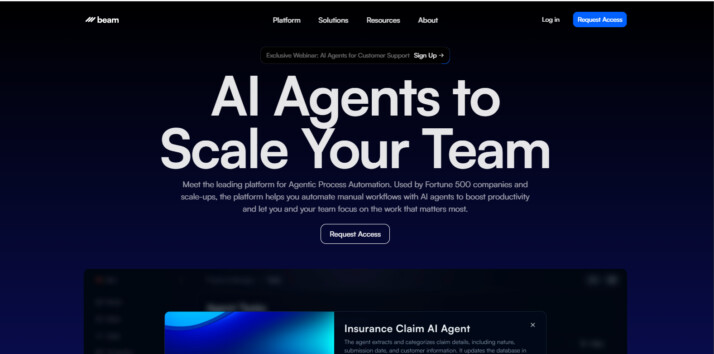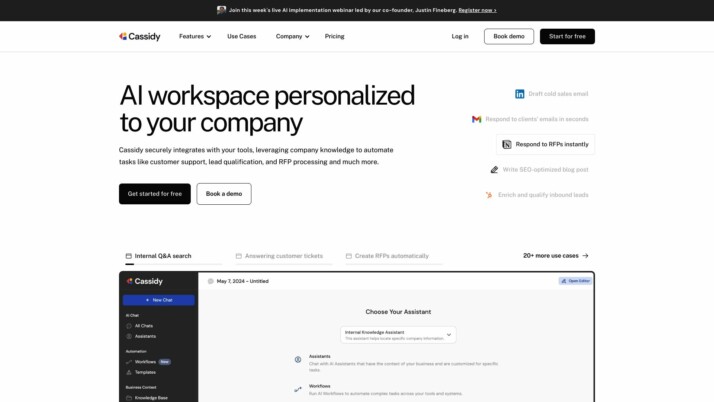Beam AI vs. Cassidy: Comparing AI Agent Platforms
AI agent platforms revolutionize how businesses automate tasks and enhance productivity. Beam AI vs. Cassidy, and SmythOS offer unique approaches to AI automation, each with distinct strengths. Beam AI specializes in autonomous, learning agents for complex workflows, while Cassidy focuses on customizable AI assistants with strong integration capabilities. SmythOS emerges as a comprehensive solution, combining powerful features with user-friendly tools. This comparison explores each platform’s core components, security measures, and overall effectiveness, helping developers, business leaders, and AI enthusiasts make informed decisions about the best AI agent platform for their needs.
Beam AI Overview
Beam AI specializes in creating intelligent AI agents designed to automate repetitive tasks and enhance productivity across organizations. These Agentic Process Automations (APAs) tackle complex workflows in areas like data extraction, customer service, compliance, and order processing. Beam AI’s agents continuously learn and adapt, becoming more efficient over time.
Beam AI specializes in creating intelligent AI agents designed to automate repetitive tasks and enhance productivity across organizations.
The platform offers customizable deployment options, supporting both on-premises and cloud environments for development and production. Beam AI emphasizes scalability, security, and integration capabilities, allowing seamless connection with existing internal systems. The agents feature advanced conversational interfaces, enabling natural interactions and efficient task management.
Beam AI prioritizes sustainability and speed, aiming to minimize steps in achieving goals and reduce human carbon footprints. The company’s international team works towards a future led by artificial general intelligence (AGI), embodying a commitment to global collaboration and innovation.


While Beam AI offers robust features for AI agent deployment and management, it lacks some tools found in other platforms. The absence of a visual builder or no-code editor may present challenges for users without technical expertise. Additionally, there’s no mention of specific debug modes or multimodal capabilities, which could limit certain advanced use cases.
Beam AI’s strength lies in its focus on autonomous, learning agents that can handle complex tasks and collaborate effectively. The platform supports multi-agent systems, human-AI interaction, and provides comprehensive logging and monitoring features. Security measures include data encryption, OAuth support, and IP control, ensuring safe and controlled access to AI capabilities.
Beam AI’s strength lies in its focus on autonomous, learning agents that can handle complex tasks and collaborate effectively.
In the competitive landscape of AI agent builders, Beam AI positions itself as a solution for organizations seeking to automate complex workflows and enhance productivity through intelligent, adaptable AI agents. Its emphasis on continuous learning and efficiency makes it particularly suitable for enterprises looking to streamline operations and reduce manual workloads.
Cassidy Overview
Cassidy empowers businesses to create customized AI automations and assistants tailored to their specific needs. The platform securely integrates with existing tools and leverages company knowledge to automate tasks like customer support, lead qualification, and RFP processing. This personalization enhances productivity by equipping AI assistants and workflows with full context unique to each organization.
Cassidy empowers businesses to create customized AI automations and assistants tailored to their specific needs.
Cassidy stands out with its model-agnostic approach, allowing users to utilize any foundational AI model. This flexibility future-proofs AI strategies and ensures businesses can adapt to evolving technologies. The platform’s integration capabilities seamlessly connect with various data sources, including Google Drive, Slack, and Notion, enabling smooth information flow across systems
Security remains a top priority for Cassidy, with enterprise-grade measures ensuring data confidentiality. The platform never uses client data for model training, maintaining strict privacy standards. For non-technical users, Cassidy offers a user-friendly workflow builder with a no-code, drag-and-drop interface. This feature democratizes AI automation, allowing teams to build complex workflows without extensive programming knowledge.


Cassidy offers a user-friendly workflow builder with a no-code, drag-and-drop interface. This feature democratizes AI automation…
Cassidy extends its functionality beyond desktop applications with browser extensions, bringing AI capabilities directly into web applications like LinkedIn and email clients. This integration enhances productivity by providing AI assistance within the tools users already rely on daily.
While Cassidy offers robust features for AI automation and integration, it lacks some advanced capabilities found in other platforms. The absence of a dedicated debug mode and limited multimodal functionalities may pose challenges for users requiring more complex AI interactions or detailed troubleshooting tools. Additionally, the platform does not mention support for data lakes or extensive crawling capabilities, which could limit its applicability in certain data-intensive scenarios.
Feature Comparison
Beam AI and Cassidy offer distinct approaches to AI agent development, with notable differences in their core components and security features. Beam AI focuses on creating autonomous, learning agents for complex workflow automation, while Cassidy emphasizes customizable AI assistants tailored to specific business needs.
In terms of core components, Beam AI lacks a visual builder and no-code editor, potentially limiting accessibility for non-technical users. Cassidy, on the other hand, provides a user-friendly workflow builder with a drag-and-drop interface, democratizing AI automation. Beam AI’s strength lies in its robust multi-agent collaboration and problem-solving capabilities, whereas Cassidy excels in integration, offering seamless connectivity with various data sources and business tools.
Security features reveal further disparities. While both platforms prioritize data protection, Beam AI offers more comprehensive security measures, including IP control and OAuth support. Cassidy emphasizes enterprise-grade security but does not explicitly mention features like IP control. This gap in security offerings could be a critical factor for organizations with stringent data protection requirements.
Feature Comparison Table
| Beam AI | Cassidy | SmythOS | |
|---|---|---|---|
| CORE FEATURES | |||
| Visual Builder | ❌ | ✅ | ✅ |
| No-Code Options | ❌ | ✅ | ✅ |
| Autonomous Agents | ✅ | ❌ | ✅ |
| Explainability & Transparency | ✅ | ❌ | ✅ |
| Debug Tools | ❌ | ✅ | ✅ |
| Multimodal | ❌ | ❌ | ✅ |
| Multi-Agent Collaboration | ✅ | ❌ | ✅ |
| Audit Logs for Analytics | ✅ | ❌ | ✅ |
| SECURITY | |||
| IP Control | ✅ | ❌ | ✅ |
| COMPONENTS | |||
| Huggingface AIs | ✅ | ❌ | ✅ |
| Classifiers | ✅ | ❌ | ✅ |
| Data Lakes | ❌ | ❌ | ✅ |
| DEPLOYMENT OPTIONS (EMBODIMENTS) | |||
| Staging Domains | ✅ | ❌ | ✅ |
| Production Domains | ✅ | ❌ | ✅ |
| API Authentication (OAuth + Key) | ✅ | ❌ | ✅ |
| Deploy as Site Chat | ✅ | ❌ | ✅ |
| Deploy as GPT | ✅ | ❌ | ✅ |
| DATA LAKE SUPPORT | |||
| Hosted Vector Database | ❌ | ❌ | ✅ |
| Sitemap Crawler | ❌ | ❌ | ✅ |
| YouTube Transcript Crawler | ❌ | ❌ | ✅ |
| URL Crawler | ❌ | ❌ | ✅ |
Best Alternative to Beam AI and Cassidy
SmythOS stands out as the superior alternative to Beam AI and Cassidy, offering a comprehensive platform for AI agent development and deployment. Our solution combines powerful features with unmatched ease of use, making it the ideal choice for businesses seeking to leverage AI technology effectively.
Unlike Beam AI and Cassidy, SmythOS provides a visual builder and no-code options, democratizing AI development for users of all skill levels. This approach significantly reduces the learning curve and accelerates the creation of sophisticated AI agents. Our platform’s intuitive drag-and-drop interface empowers users to design complex workflows without extensive coding knowledge, a feature notably absent in Beam AI.
SmythOS provides a visual builder and no-code options, democratizing AI development for users of all skill levels. This approach significantly reduces the learning curve and accelerates the creation of sophisticated AI agents.
SmythOS excels in its extensive feature set, surpassing both Beam AI and Cassidy in critical areas. We offer robust multi-agent collaboration capabilities, allowing teams of AI agents to work together on complex tasks — a functionality limited in Cassidy’s offerings. Our platform also provides superior explainability and transparency tools, enabling users to understand and trust the decision-making processes of their AI agents, addressing a key limitation in Cassidy’s platform.
Security and scalability set SmythOS apart from its competitors. While Beam AI offers some security features, SmythOS provides a more comprehensive suite of security measures, including data encryption, OAuth support, and IP control. These features ensure that your AI agents operate in a secure environment, protecting sensitive data and maintaining compliance with industry standards. Additionally, our platform’s scalability allows for seamless growth as your AI needs expand, a crucial factor often overlooked by other solutions.
SmythOS provides a more comprehensive suite of security measures, including data encryption, OAuth support, and IP control. These features ensure that your AI agents operate in a secure environment…
With SmythOS, the possibilities for AI agent deployment are virtually unlimited. Our platform supports a wide range of use cases, from customer service chatbots to complex data analysis tools, all deployable across multiple channels. This versatility, combined with our advanced integration capabilities, ensures that SmythOS can adapt to any business requirement, outpacing the more limited offerings of Beam AI and Cassidy.
Conclusion
Beam AI, Cassidy, and SmythOS each offer unique approaches to AI agent development and deployment. Beam AI excels in creating autonomous, learning agents for complex workflow automation, while Cassidy provides customizable AI assistants with strong integration capabilities. However, SmythOS emerges as the superior choice, offering a comprehensive platform that combines the strengths of its competitors with additional powerful features.
SmythOS stands out with its intuitive drag-and-drop interface, extensive integration ecosystem, and versatile deployment options. The platform’s ability to support multi-agent orchestration and its pre-built API integrations make it incredibly user-friendly and efficient. Unlike Beam AI, which lacks a visual builder, SmythOS democratizes AI development, making it accessible to both technical and non-technical users.
While Cassidy offers a user-friendly workflow builder, SmythOS takes it a step further by providing a more robust set of tools for creating complex AI workflows. The platform’s support for various AI models, including those from OpenAI, Anthropic, and Hugging Face, ensures flexibility and future-proofing that surpasses Cassidy’s model-agnostic approach.
For businesses and developers looking to harness the full potential of AI, SmythOS offers the most comprehensive solution. Its ability to deploy agents across multiple platforms, including as ChatGPT plugins or Alexa skills, provides unparalleled versatility. We invite you to explore our diverse range of AI-powered agent templates and experience unlimited AI automation risk-free. Unlock the power of SmythOS and revolutionize your approach to AI development and deployment today.
Last updated:
Disclaimer: The information presented in this article is for general informational purposes only and is provided as is. While we strive to keep the content up-to-date and accurate, we make no representations or warranties of any kind, express or implied, about the completeness, accuracy, reliability, suitability, or availability of the information contained in this article.
Any reliance you place on such information is strictly at your own risk. We reserve the right to make additions, deletions, or modifications to the contents of this article at any time without prior notice.
In no event will we be liable for any loss or damage including without limitation, indirect or consequential loss or damage, or any loss or damage whatsoever arising from loss of data, profits, or any other loss not specified herein arising out of, or in connection with, the use of this article.
Despite our best efforts, this article may contain oversights, errors, or omissions. If you notice any inaccuracies or have concerns about the content, please report them through our content feedback form. Your input helps us maintain the quality and reliability of our information.
